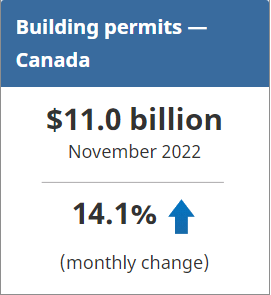Statistics Canada: Building Permits November 2022
The total value of building permits in Canada jumped 14.1% in November to $11.0 billion, rebounding after two consecutive monthly losses.

On a constant dollar basis (2012=100), the total value of building permits went up 12.3% to $6.5 billion.
Multi-unit dwelling component drives residential sector growth
The value of residential permits increased 13.7% to $7.1 billion nationally in November.
The value of building permits in the multi-family dwelling component was up 19.0%. Ontario contributed to much of the growth with 21 permits for new condominiums and apartments valued at over $10 million. The total number of planned dwelling units in Ontario grew 60% month over month, returning to historical averages reported over the last three years.
The single-family dwelling component advanced 7.1% following four consecutive monthly declines. Gains were posted in seven provinces. Despite the increase in value, the number of dwelling units posted its sixth consecutive monthly decrease.
Ontario pushes up non-residential sector
The total permit value of the non-residential sector rose 14.9% to $3.9 billion in November.
The value of permits in the institutional component strongly increased (+40.6%). Much of the gain was because of a new courthouse planned for development in Toronto valued at just over $500 million. This project helped offset losses posted in six provinces.
The value of building permits in the industrial component showed a strong progression (+32.4%) following significant gains the previous month. Ontario led the way with a $425 million permit for a manufacturing plant in Toronto.
Construction intentions in the commercial component edged down 0.6%, mostly because of losses posted in British Columbia.
To explore data using an interactive user interface, visit the Building permits: Interactive Dashboard.
To explore the impact of the COVID-19 pandemic on the socioeconomic landscape, please consult the Canadian Economic Dashboard and COVID-19.
For more information on housing, please visit the Housing statistics portal.
Statistics Canada has a Housing Market Indicators dashboard. This web application provides access to key housing market indicators for Canada, by province and by census metropolitan area. The indicators are updated automatically with new information from monthly releases, giving users access to the latest data.
Note to readers
Unless otherwise stated, this release presents seasonally adjusted data with current dollar values, which facilitate month-to-month and quarter-to-quarter comparisons by removing the effects of seasonal variations. For information on seasonal adjustment, see Seasonally adjusted data – Frequently asked questions.
Building components
- Single-family dwellings: Residential buildings containing only one dwelling unit (e.g., single-detached house, bungalow, linked home [linked at the foundation]).
- Multi-family dwellings: Residential buildings containing multiple dwelling units (e.g., apartment, apartment condominium, row house, semi-detached house).
- Industrial buildings: Buildings used in the processing or production of goods or related to transportation and communication.
- Commercial buildings: Buildings used in the trade or distribution of goods and services, including office buildings.
- Institutional and government buildings: Buildings used to house public and semi-public services, such as those related to health and welfare, education or public administration, and buildings used for religious services.
Revision
Data are subject to revisions based on late responses, methodological changes and classification updates. Unadjusted data has been revised for the previous month. Seasonally adjusted data has been revised for the previous three months.
For information on trend-cycle data, see the StatCan Blog and Trend-cycle estimates – Frequently asked questions.
Next release
Data on building permits for December will be released on February 2, 2023.
Source: Statistics Canada

